Japan
Wood Products Prices
Dollar Exchange Rates of 10th
September
2025
Japan Yen 147.52
Reports From Japan
Is timing for an interest rate hike approaching?
Japan’s economy expanded in the second quarter the
government confirmed in a revised report as data for
private consumption were revised higher. Gross domestic
product grew at an annualised pace of 2.2% the Cabinet
Office reported. The economy has now grown for five
consecutive quarters.
The consumption report confirms that consumer spending
gained momentum and capital investment remained
positive despite. Takeshi Minami, Chief Economist at the
Norinchukin Research Institute said "this outcome reflects
a positive cycle of wage increases and rising prices as the
Bank of Japan (BoJ) anticipated and I believe the timing
for an interest rate hike is approaching.”
Japan’s economy is struggling amid high inflation and a
global slowdown. The main drags to growth came from
the public sector and exports.
Wage growth announcements at this year’s shunto (wage
negotiations held in spring between employers and unions)
were quite strong and this fueled speculation that
consumer spending would strengthen, driving stronger
underlying inflation and higher wage growth. Despite the
announcements of such strong wage increases, total wage
growth in Japan remains relatively weak.
One of the most uncertain aspects of the Cabinet outlook
revolves around international trade. Evidence of a
slowdown in trade is already showing up in the data.
Japanese goods exports had surged in the first quarter of
2025 ahead of tariffs but had fallen by 1.7% in May on a
year on year basis. Unsurprisingly, goods exports to the
United States were notably weak, falling 11% over the
same period.
See:
https://www.japantimes.co.jp/business/2025/09/08/economy/gros
s-domestic-product-grew-22-last-quarter/
Japan business sentiment
Japan’s Business Survey Index (BSI) for large
manufacturing firms unexpectedly rose to 3.8% in the
third quarter of 2025, up from -4.8% in the previous
quarter, the lowest reading since early 2024.
The BSI, based on a survey of large Japanese
manufacturers, serves as a key gauge of economic health
in a country heavily reliant on industrial output.
Manufacturers remain optimistic about the months ahead,
projecting a further rise to 3.9% in final quarter of 2025
followed by a slight decline to 3.3% in the first quarter of
2026.
See: https://www.cao.go.jp/index.html
Retirement crisis facing workers of the ‘Lost Decades’
The term “employment ice age” has been coined to
describe the first decade of corporate retrenchment (mid-
1990s through early 2000s) following the collapse of
Japan’s 1980s asset-price bubble. Young people who
entered the work force during those years had a hard time
securing “regular” corporate jobs and those struggles have
had a lasting impact on their average income, savings and
cumulative pension contributions.
Now in their forties or early fifties, many members of the
“ice-age generation” (here, comprising all those who
completed their school education between 1993 and 2004)
are facing the prospect of a retirement crisis and
policymakers have begun searching for a solution. In June
a ministerial council dedicated to this issue submitted a
“basic framework for new programmes to support the
‘employment ice age’ generation and others.
See: https://www.nippon.com/en/in-depth/d01155/
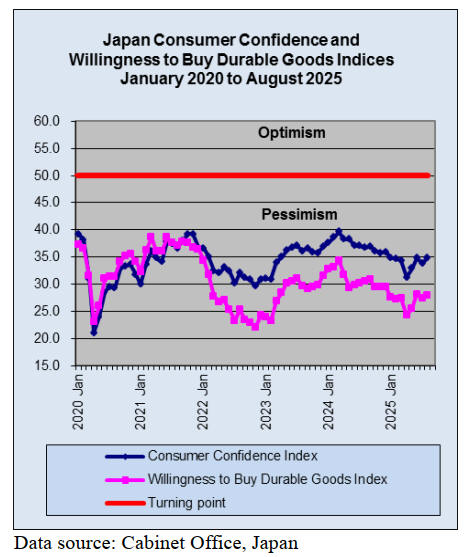
Yen exchange rate temporarily tilted by Prime
Minister’s comments
The yen has been weakening once again. The Japanese
currency traded at the 147 level against the dollar in early
September but at one point the yen fell below 149 against
the dollar. Expectations that the US Federal Reserve could
announce a major interest rate cut at its next meeting in
November have moderated and many are now anticipating
that US interest rates will continue to remain high for
some time.
Another reason cited for the short-term yen decline was
that the Prime Minister told reporters he personally thinks
Japan is not ready for an additional interest rates hike. The
market reacted sharply to his remarks.
See: https://www3.nhk.or.jp/nhkworld/en/news/backstories/3594/
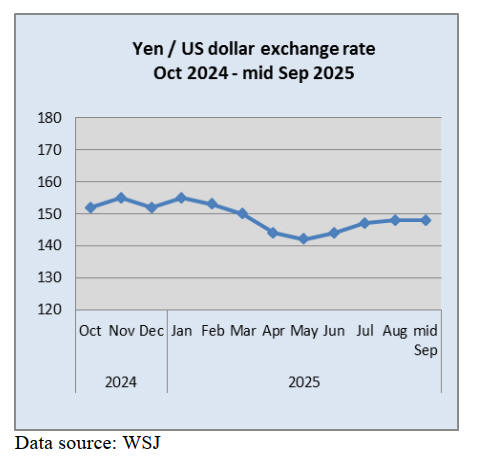
High rents dampening personal consumption
Tokyo rents have soared reaching their highest rate of
increase in 30 years and now account for over 30% of
household income which is squeezing family finances and
potentially dampening personal consumption.
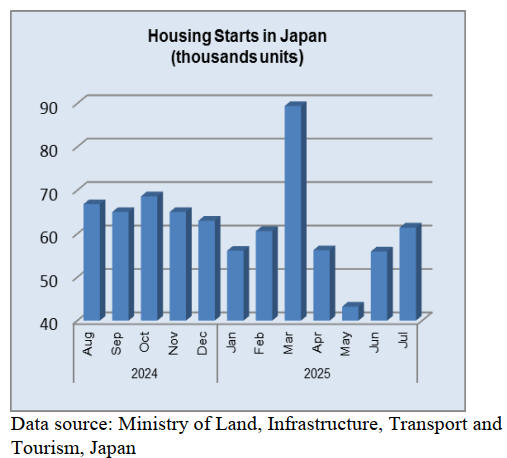
This surge, driven by increased demand for urban centre
apartments and rising construction costs signifies the
inflation cycle impacting Japan's housing market and
could lead to further Bank of Japan interest rate hikes, says
a Nikkei Real Estate Market report.
See: https://asia.nikkei.com/business/markets/property/tokyo-
rents-soar-past-30-of-household-income-squeezing-families

Assembled wooden flooring imports
In the first half of 2025 assembled flooring imports were
15% higher than in the same period in 2024. The main
category of assembled flooring imports in July 2025 was
HS441875, accounting for 62% (61% in June) of the total
value of assembled flooring imports. Of HS441875
imports, 80% was provided by shippers in China, Viet
Nam and Thailand. The other main sources of assembled
flooring (HS441875) in July were Indonesia and
Lithuania, a new supplier.
The second largest category in terms of value in July 2025
was HS441879, 75% of which was shipped from China. A
further 18% was shipped from Indonesia and Thailand.
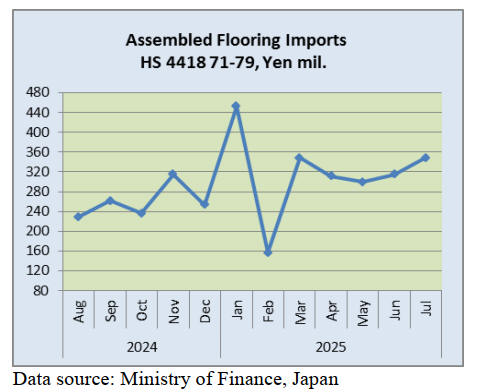
Plywood imports
In the first half of 2025 there was a modest 3% year on
year rise in the volume of plywood imports into Japan.
Shipments in the first half of 2025 from China dropped
25% year on year while import volumes from the other
three main shippers; Malaysia, Indonesia and Viet Nam
were at almost the same level and in the first half of 2024.
In July, Malaysia and Indonesia were the top suppliers of
plywood to Japan, as in previous months. The volume of
July 2025 imports from Malaysia was almost 50% above
the volume reported for July 2024 and year on year there
was a 37% increase. July imports from Indonesia were
down slightly month on month and little changed from the
volume reported for July 2024.
Imports of plywood from China in July were at around the
same level as in June but year on year there was a 25%
decline in arrivals.
In July 2025 arrivals of HS441210-39 were reported at
137,732 cu.m (121,000 cu.m in June) up 7% year on year
and up 14% compared to June.
As in previous months, of the various categories of
plywood imported in July 2025, HS441231 was the largest
followed by HS441233 and HS441234 (5%). The balance
was of HS441239.
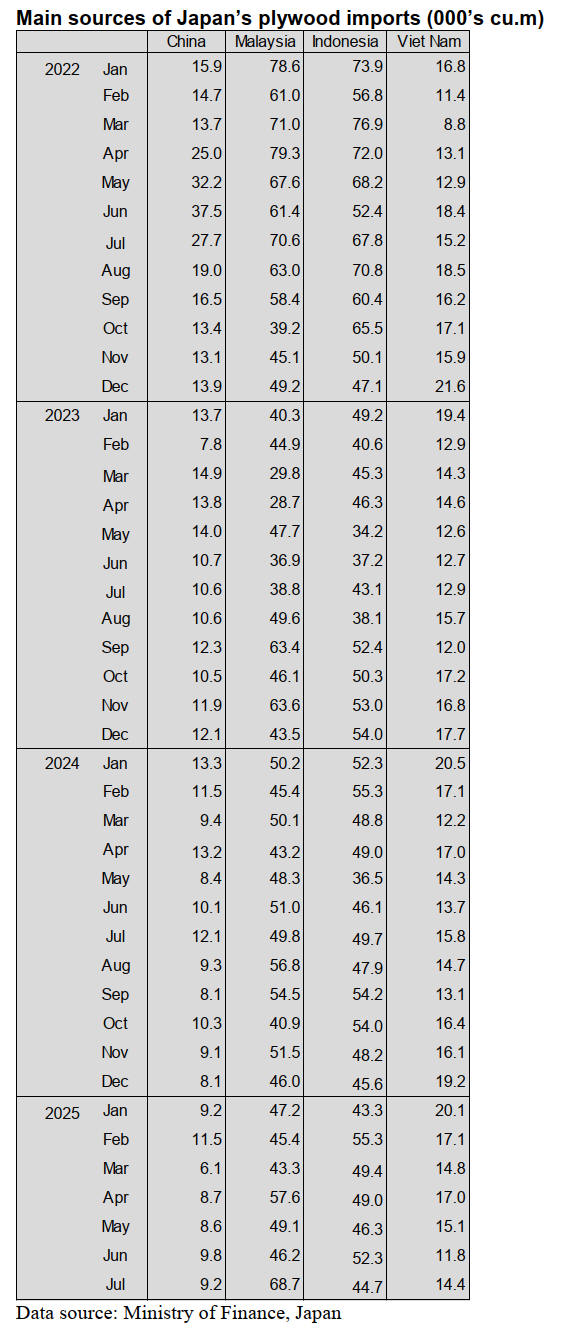
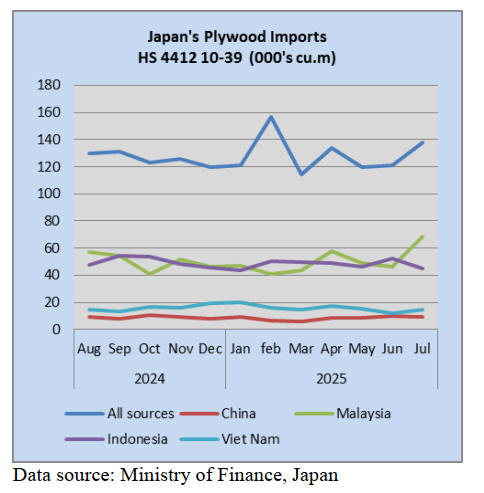
Trade news from the Japan Lumber Reports (JLR)
The Japan Lumber Reports (JLR), a subscription trade
journal published every two weeks in English, is
generously allowing the ITTO Tropical Timber Market
Report to reproduce news on the Japanese market
precisely as it appears in the JLR.
For the JLR report please see:
https://jfpj.jp/japan_lumber_reports/
North American logs
Log demand in Japan remains sluggish due to a shift
toward domestic cedar and cypress, as well as weak
overall market activity. Production adjustments may be
necessary in the future. Prices for U.S. Douglas fir logs for
Japan, IS grade, FAS, MBM, Scribner scale, remain flat at
around US$1,020 compared to July shipments. Domestic
supply and demand levels are still low.
Canadian Douglas fir logs for plywood exports to Japan
are also stable at US$220–US$221, CIF per cbm,
following a July price increase. At an exchange rate of
¥147/USD, the landed cost is estimated at around ¥34,100.
KD Douglas fir lumber prices remain flat, ¥68,000–
¥71,000/m³ for 105×150–270mm beams, around
¥80,000/m³ for square beams, and ¥85,000–¥88,000/m³
for 60×45 mm small-cut lumber (delivered to precut
factories).
Weak demand and the lower cost of domestic wood make
price increases difficult. Precutting plants operating rates
have yet to recover, and August saw limited activity due to
extreme heat and fewer working days. A recovery in
demand is hoped for in the fall.
A recent fire at a major imported lumber manufacturer has
had no impact so far, and Douglas fir lumber remains
sufficiently supplied. Companies handling U.S. and
Canadian wood are closely monitoring potential supply
disruptions and network restructuring from September
onward.
Plywood
Demand for domestic softwood plywood remains weak,
largely due to sluggish new housing starts. However,
shipments improved from late July to early August as
buyers stocked up ahead of the Obon holiday. With
manufacturers maintaining a firm stance on price hikes,
some buyers moved to secure inventory, anticipating price
stability. As of late August, though, shipment activity has
slowed again.
Major plywood manufacturers aimed to raise prices in
August for 12 mm 3 x 6 domestic structural softwood
plywood to ¥1,150–¥1,200 per sheet, delivered. However,
due to weak demand, prices remained mostly flat, with
central Tokyo rates holding at ¥1,090–¥1,100.
Prices for imported tropical plywood from Indonesia and
Malaysia are trending firm, driven by reduced log supply
from inland areas and rising raw material costs. In
Sarawak, Malaysia, a major supplier raised prices by about
US$10, C&F per cbm, in July. As a result, prices for 12
mm coated formwork plywood are US$600–US$610 per
cbm, standard formwork plywood US$500–US$510 per
cbm, and structural plywood US$510–US$520 per cbm.
The Malaysian ringgit has strengthened against the dollar
since early April, keeping production costs
high.Indonesian standard plywood is priced at around
US$970 per cbm for 2.4 thickness, US$880 per cbm for
3.7 mm, and US$850 per cbm for 5.2 mm. Both natural
tropical wood plywood and falcata combo plywood face
rising production costs, prompting firm pricing from
suppliers.
Domestic prices are as follows: 12 mm 3 x 6 coated
formwork plywood for construction use is ¥1,800–¥1,850
per sheet, standard formwork and structural plywood are
around ¥1,550, and standard plywood is ¥780 for 2.5 mm,
¥930 for 4 mm, and ¥1,100 for 5.5 mm thickness
Domestic logs and lumber
Domestic softwood lumber showed mixed trends in July
and early August. Market activity remained sluggish, and
demand varied among trading companies supplying
builders.
Supply and demand eased slightly, causing modest price
drops for top-grade items like cedar posts and cypress
foundation timbers, especially in northern Kanto. Cedar
105 mm KD premium posts fell to ¥55,000– 58,000 per
cbm, and cypress equivalents to ¥75,000–78,000 per
cbm—both down about ¥3,000.
Unlike last year’s nationwide decline, cedar log prices
stayed high, especially in producing regions. In Kyushu, 3
m cedar logs in Miyazaki reached ¥16,000 per cbm and 4
m logs in Oita ¥14,500 per cbm—both up ¥2,000 year-on-
year. In northern Kanto, Tochigi logs rose to ¥15,500 per
cbm and Akita logs to ¥15,000 per cbm.
Cypress prices climbed in western Japan. In Shikoku, 3 m
and 4 m logs for posts and foundations rose to ¥25,000–
25,600 per cbm—up ¥ 2,000 from last month and over
¥5,000 year-on-year. In Okayama, logs fell ¥1,500 to
¥24,000 per cbm but remained up compared to last year.
Prices in Kyushu and northern Kanto also stayed high
relative to 2024 levels.
South Sea log and products
Shipments of Southeast Asian and Chinese wood products
remain slow. While commercial-use materials like decking
see steady orders, residential demand continues to
stagnate. Domestic distributors are buying only what's
needed for immediate projects, as housing starts stay
weak.
Despite low demand from Japan, Southeast Asian
producers are hesitant to cut prices due to inflation and
rising costs. With the yen still falling, import prices remain
high. Japanese buyers are limiting purchases to short-term
needs.
Some distributors report growing interest in alternative
materials for furniture and interior/exterior use, driven by
rising import costs and global trade uncertainty, including
U.S. tariffs. No Southeast Asian logs arrived in June, but
existing inventory has reached end users, and shortages are
not expected.
Plywood supply in first half of 2025
Total plywood supply during January to June, 2025 is
2,336,000 cbms, 3.1 % more than January to June 2024.
The reason is that production of domestic plywood
1,304,000 cbms, 6.2 % more than the same period last
year.
The new starts during January to June, 2025 is 7.5 % less
than the same period last year. Due to the price increases
by plywood manufacturers starting in January, demand-
side purchasing interest in softwood structural plywood
appears to have improved compared to last year’s
prolonged downturn. Imported plywood is 1,032,000
cbms, 0.6 % less than the same period last year.
Production of domestic structural softwood plywood in the
first half of this year is 6.7 % more than the same period
last year. Shipment is 8.9 % more than the same period
last year. Although market activity was sluggish in June,
the monthly performance was the lowest of the first half of
the year—yet still reached the 180,000 cbms range.
Considering that the monthly average in the first half of
last year was approximately 178,000 cbms, the overall
situation has recovered.
There was an increase in Indonesian plywood by 0.9 %
from the same period last year. Malaysian plywood is 1.6
% less than the same period last year. Due to
developments surrounding the Trump tariffs, exchange
rates remained volatile, and importers continued to focus
on procuring only the necessary designated sources.
In Malaysia’s Sarawak State, heavy rains and flooding
occurred in early February. As a result, delays in log
transportation and localized inundation caused a
slowdown in production at local plywood factories. As a
result, domestic inventory shortages were anticipated
around March to May. However, local manufacturers
continued production using work-in-progress stock, and
shipments arrived despite some delays, limiting the
shortage to certain items such as South Sea structural
plywood.
Chinese plywood during January to June, 2025 is 9.3 %
less than the same period last year. Vietnamese plywood is
11.0 % increased.
Solid-wood surface flooring hits Japanese market
Hokuyo Trading has begun domestic sales in Japan of
three-layer flooring with a solid wood surface,
manufactured by the German flooring company
PARADOR. It is rare for parquet flooring that meets
European standards to be compatible with low-profile
floor heating systems. Delivery is scheduled to begin in
October, with a target of selling 4,000 cbms in the first
year.
The product is designed to offer the same appearance and
texture as solid wood flooring, with a top layer made of
approximately 2.5 mm thick solid oak.
By combining a high-quality substrate layer,
approximately 9 mm thick and made of SPF wood,
beneath the surface, the flooring is designed to minimize
the natural tendencies of solid wood such as expansion,
warping, and cracking, thereby ensuring excellent
dimensional stability.
|